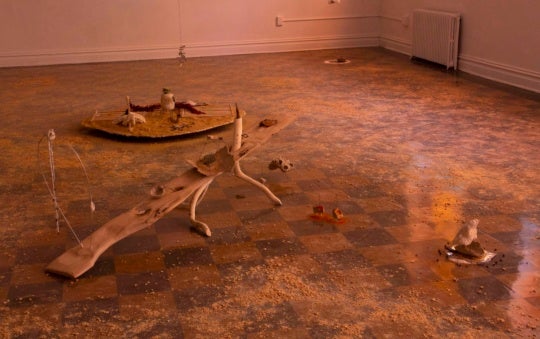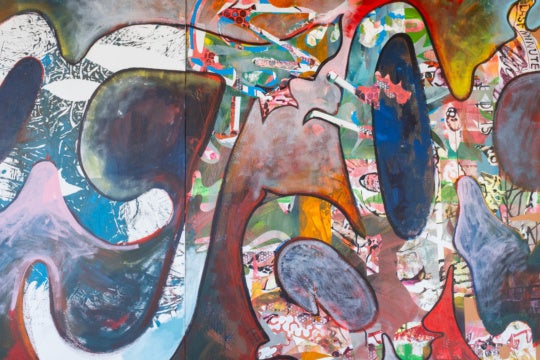
A living tree growing (yes, growing!) from a planter inset into the mattress of a charred, wooden-framed hospital bed is the first work visitors encounter when entering “Epiphany is Not a Blazing Light,” a show of new works by Romy Aura Maloon, on view through June 20 at Beep Beep Gallery. The displaced tree suggests Maloon’s own circumstances: she is a first-generation American born to South-African Jewish parents. Moreover, the blunt juxtaposition of growing organism and inanimate object (made from a dead tree, of course) has surrealistic flavor, in part because it’s typical to expect a person, not a tree, in a bed. The tension of this scenario sets up a duality that underscores the entirety of Maloon’s exhibition, as do the associations inevitably attached to a bed beyond sleep and rest—birth and procreation, illness and death.
Maloon borrowed the show’s evocative title from a poem by Martín Espada dedicated to the deceased leftist author Adrian Mitchell. (The gallery provides printed copies.) In the poem, Espada likens the revelation of epiphany not to a single burst of insight but rather to thoughtfulness and the act of writing itself. Due to its elevation of artistic expression, the poem is likely to appeal to those of creative inclination who experience grief. At the opening, Maloon told me that the loss of someone close to her was foundational to this body of work. Such insight is useful but not essential to glean meaning from Maloon’s work. Perhaps the poem acts as an appropriated artist’s statement of sorts—simultaneously suggesting and evading the deeply personal nature of the show, all the while speaking to a more universal need to write, paint, sculpt, or in Maloon’s case, burn a bed and plant a tree in it.

Throughout the works on paper, sculptures, and installation, Maloon confines herself to a handful of motifs that she returns to again and again. Near the bed, three sheer white canopies hang from gold-toned towing chains that pool, rootlike, in loose spirals in a bed of artificial red flowers. They are part of a group of sculptures collectively titled The Kissed Her Shadow as She Walked Past 1-6. Probably a reference to Maloon’s lineage, boer (a South African goat) bones hang intermittently from the chains. There is something anthropomorphic, albeit spectral, about these tall, hanging sculptures.
Mirroring and doubling are consistent throughout Maloon’s exhibition. The layout of the gallery is such that the left and right walls are almost exactly the same but reversed (group of drawings on one side, three canopies on the other). In the back of the room, a human silhouette is painted on the wall in gold paint. Two chains link the figure at the waist to two freestanding animal sculptures, titled Red Coyote 1 and Red Coyote 2, which are constructed from red blossoms.

Variations of the sculptures’ subjects appear in individual works on paper. In drawings and prints, Maloon either shows a figure being led by two yoked, open-mouthed dogs around whom roses float, or she draws the tree-and-bed motif with the addition of another pair of dangerous-looking canines. Maloon often interrupts her precise graphic rendering style—heavy on contour lines and hatching—with materials and techniques that are suggestive of disintegration (burn marks) as well as artifice (nail polish). Though marked by variation, Maloon’s purposeful repetition invites the viewer to consider the artist’s process: is this an act of compulsive obsession or is it catharsis? I lean toward the latter.
The layout of the exhibition is a strength, as is its cohesiveness. Yet, it may have benefited Maloon—given her penchant for repetition and interest in artifice and decay—to push further into the territory of gilt excess. (Full disclosure: philosophically and aesthetically speaking, I’m a more-is-more kind of girl.) Indeed, I’d like to see further exploration of material since she’s so good at it. Nail polish might be used less sparingly, for example. That said, the artist’s decisiveness throughout the show works.

In Beep Beep’s smaller back gallery, Maloon displays a less grandiose collection of objects in black-and-white and faded hues. A group of 12 white plates are decorated with spiders and small globs of kiln-fired glass that look like gelatinous sacks, evoking eggs or webs. In a corner below the plates, a pile of fake pastel blossoms makes a bed for three life-size ceramic heads, each sculpture teeming with tiny flora and fauna. Nestled in the mound of flowers that bear mottled splotches of mold and rot (like musty blooms from Miss Emily’s trousseau, I imagine), the work suggests disintegration in a matter-of-fact way Again the show’s layout is significant: when standing in the first room, the wall with the shadowy painted figure masks the ceramic heads analogous to the way a body hides its innards. To me, this is the show’s dark heart—a heap of ersatz organic matter acting as a contemporary momento mori.

Epilogue (of sorts): About a week after the opening, I visited Beep Beep again. Already, the tree has shed leaves. Scattered on the sheets and floor, they remind the viewer of inevitable demise. A small bundle of dried flowers rested elegiacally on the bed among the dried leaves and other detritus. Of course, a living thing will change over time; in contrast, the false blooms of the rest of show maintain their vivid colors. A tiny black insect that was crawling on the tree’s thin trunk suggested renewal and the biological complexity of life. Ultimately all living things, like Maloon’s everyman figure linked to the wild dogs, belongs to a web of natural forces both gruesome and beautiful.
Rebecca Brantley lives in Athens, Georgia, and teaches for Piedmont College and the University System of Georgia. She is board president at ATHICA: Athens Institute for Contemporary Art. She is currently a participant in BURNAWAY’s Emerging Art Writers Mentorship Program.




